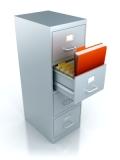How to Organize Office Files

Once you know how to organize office files, you’ll notice one tangible benefit:
Less time wasted searching for what you want.
The focus of this article is simply to help you to do that consistently so you can use your time for more important things.
An added bonus (which, in many respects, matters just as much) are the feelings of calm and control you ‘earn’ from your decision to learn how to organize office files.
Let’s be honest, though -- filing will never be fun.
That being the case, let’s look at how to organize office files so you can get to what you want quickly and easily...
1. Block off some time
When can you do this?
You’ll need a good chunk of time to make any headway.
Obviously, everyone’s workspace is different -- some people have a messy office with huge piles of papers to deal with.
You may find fencing off an afternoon is a good time to do this. Attempting to organize files in the morning may well use up your energy and creative juices, leaving you more tired and less productive later on.
2. Set up
Physical filing (as opposed to the digital kind) depends upon the quality and location of your filing cabinet.
When you want to file, do you have to leave your desk to do it?
This probably costs you several minutes each day.
As far as possible, put your file organizer close enough to your desk for you not to have to leave your chair, particularly your Action files (see below).
Make sure you have enough suspension files and labels, then…
3. Get started
Whether you want to improve your current filing system, or learn how to organize office files from scratch, you have to start somewhere. And that somewhere is as much or as little of your paperwork as you like.
Don’t try and do everything in one go -- you’ll get overwhelmed. Instead, learn how to avoid procrastination by time boxing a number of minutes, then work for that period.
A major cause of a messy desk is uncertainty about what to do with paper.
People don’t know what to do with it so it stays on the desktop. In fact, when you know how to organize paperwork it can all be accounted for.
You just need to…
4. Decide and divide
Your files can be categorized using the ART acronym:
For each item to be (re-)filed, which one is appropriate?
Trash (or preferably recycle) anything you decide you no longer need. This alone will significantly streamline your office filing operations.
If something needs to be actioned, particularly if it’s date sensitive, use a tickler file to keep tabs on what needs doing or using, and when.
Set up your reference files separately from your action files.
You can index your files one of two ways:
- Alphabetically. Self explanatory. Subdivide if necessary, i.e. Aa, Ab
- Date last used. Whatever file you used most recently, return it to the front of the cabinet or, alternatively, one end of the shelf. This means your most used files will always be easiest to access.
Filing is boring, but it doesn’t have to be quite so bad.
Small changes can make a big difference to how you feel. For example, invest in coloured folders rather than plain.
5. Maintain
One of the most important principles of time management is “little and often”, and this definitely applies to your filing.
Do some filing daily -- it doesn’t have to be much. How long you file for is far less important than the fact that you do it each working day.
You can do it at a regular point in the day. or whenever it suits you.
The key is regular, focused filing – it will transform your workspace, and if you want to know how to organize office files, this is a must-do.
Summary:
- Block off some time to do it
- Maintain
- Home ›
- How to Get Organized ›
- How to Organize Office Files

